This document provides an overview of brute force and divide-and-conquer algorithms. It discusses various brute force algorithms like computing an, string matching, closest pair problem, convex hull problems, and exhaustive search algorithms like the traveling salesman problem and knapsack problem. It also analyzes the time efficiency of these brute force algorithms. The document then discusses the divide-and-conquer approach and provides examples like merge sort, quicksort, and matrix multiplication. It provides pseudocode and analysis for mergesort. In summary, the document covers brute force and divide-and-conquer techniques for solving algorithmic problems.

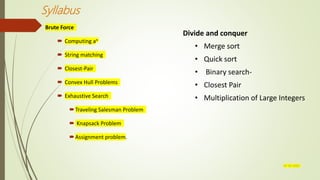

![Brute-Force Sorting Algorithm
Selection Sort
Scan the array to find its smallest element and swap it with the first element.
Then, starting with the second element, scan the elements to the right of it
to find the smallest among them and swap it with the second element.
Generally, on pass i (0 i n-2), find the smallest element in A[i..n-1] and
swap it with A[i]:
07-03-2022](https://image.slidesharecdn.com/unit2-220307075928/85/Unit-2-4-320.jpg)







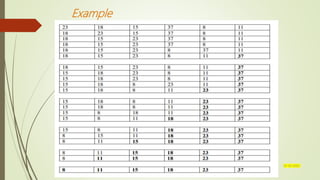







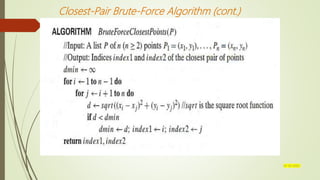




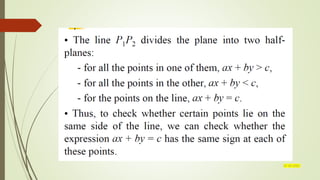


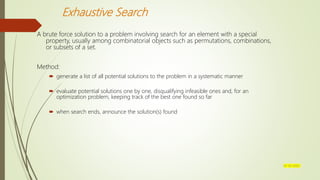






![Example 3: The Assignment Problem
There are n people who need to be assigned to n jobs, one person per job. The
cost of assigning person i to job j is C[i,j]. Find an assignment that minimizes the
total cost.
Job 0 Job 1 Job 2 Job 3
Person 0 9 2 7 8
Person 1 6 4 3 7
Person 2 5 8 1 8
Person 3 7 6 9 4
Algorithmic Plan: Generate all legitimate assignments, compute
their costs, and select the cheapest one.
How many assignments are there?
07-03-2022](https://image.slidesharecdn.com/unit2-220307075928/85/Unit-2-35-320.jpg)










![Mergesort
Split array A[0..n-1] in two about equal halves and make copies of each half in arrays B and C
Sort arrays B and C recursively
Merge sorted arrays B and C into array A as follows:
Repeat the following until no elements remain in one of the arrays:
compare the first elements in the remaining unprocessed portions of
the arrays
copy the smaller of the two into A, while incrementing the index
indicating the unprocessed portion of that array
Once all elements in one of the arrays are processed, copy the remaining
unprocessed elements from the other array into A.
07-03-2022](https://image.slidesharecdn.com/unit2-220307075928/85/Unit-2-46-320.jpg)




![Quicksort
Select a pivot (partitioning element) – here, the first element
Rearrange the list so that all the elements in the first s positions are smaller than or equal to the pivot
and all the elements in the remaining n-s positions are larger than or equal to the pivot (see next slide
for an algorithm)
Exchange the pivot with the last element in the first (i.e., ) subarray — the pivot is now in its final
position
Sort the two subarrays recursively
p
A[i]p A[i]p
07-03-2022](https://image.slidesharecdn.com/unit2-220307075928/85/Unit-2-51-320.jpg)



![Binary Search
Very efficient algorithm for searching in sorted array:
K
vs
A[0] . . . A[m] . . . A[n-1]
If K = A[m], stop (successful search); otherwise, continue
searching by the same method in A[0..m-1] if K < A[m]
and in A[m+1..n-1] if K > A[m]
l 0; r n-1
while l r do
m (l+r)/2
if K = A[m] return m
else if K < A[m] r m-1
else l m+1
return -1
07-03-2022](https://image.slidesharecdn.com/unit2-220307075928/85/Unit-2-55-320.jpg)




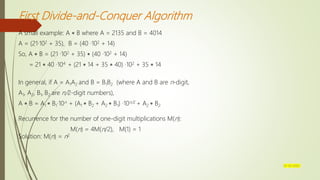


![Strassen’s Matrix Multiplication
Strassen observed [1969] that the product of two matrices can be computed as follows:
C00 C01 A00 A01 B00 B01
= *
C10 C11 A10 A11 B10 B11
M1 + M4 - M5 + M7 M3 + M5
=
M2 + M4 M1 + M3 - M2 + M6
07-03-2022](https://image.slidesharecdn.com/unit2-220307075928/85/Unit-2-63-320.jpg)







